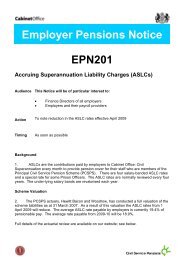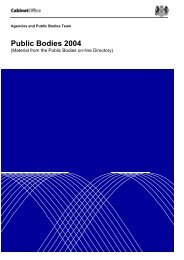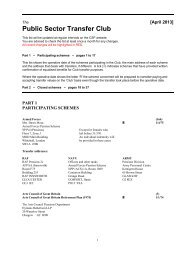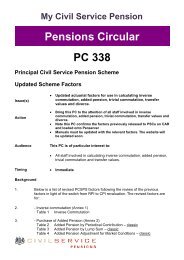Job Evaluation Good Practice Guide - The Civil Service
Job Evaluation Good Practice Guide - The Civil Service
Job Evaluation Good Practice Guide - The Civil Service
You also want an ePaper? Increase the reach of your titles
YUMPU automatically turns print PDFs into web optimized ePapers that Google loves.
<strong>Job</strong> <strong>Evaluation</strong><strong>Good</strong> <strong>Practice</strong> <strong>Guide</strong>October 2007
CONTENTSPageINTRODUCTION 1-2Purpose of the <strong>Guide</strong> 1Central Responsibility and Support for JEGS 1<strong>The</strong> Role of <strong>Job</strong> <strong>Evaluation</strong> 1Discrimination 1-2ADOPTING OR REVIEWING JEGS 3-4APPLYING JEGS 5JEGS Practitioners 5<strong>The</strong> JEGS Process 5<strong>Job</strong> Analysis Form 5Interview 6Write Up 6-7Analysis 7Quality Assurance 7-8Appeals 8RESPONSIBILITY FOR JEGS 8ADDITIONAL GUIDANCE 8ANNEXES1. Equal Pay Legislation – A Summary2. <strong>Job</strong> Analysis Form
INTRODUCTIONPurpose of the <strong>Guide</strong>This guide is intended to raise awareness of good practice in the applicationand maintenance of the <strong>Job</strong> <strong>Evaluation</strong> and Grading Support (JEGS) system.For JEGS practitioners, it should be used as a supplement to the JEGShandbook - but it is also intended for use by anyone else involved with theJEGS process.Central Responsibility and Support for JEGS<strong>The</strong> Cabinet Office is responsible for the integrity of JEGS. This responsibilityincludes: the maintenance and development of the JEGS methodology inconsultation with Towers Perrin (who own the copyright to the software);oversight of training standards through a framework agreement held with atraining provider; approving organisations’ amendments to the JEGShandbook; and giving strategic advice to users on standards of applicationand good practice in JEGS and job evaluation generally. For furtherinformation and guidance please contact:-Stephen King or Beverley PyeCabinet Office<strong>Civil</strong> <strong>Service</strong> Capability GroupRoom 2. 6Admiralty Arch<strong>The</strong> MallLondon SW1A 2WHTel. 020-7276-2230 or 020-7276-1783<strong>The</strong> Role of <strong>Job</strong> <strong>Evaluation</strong><strong>The</strong> aim of job evaluation is to provide a systematic, fair and consistent meansof measuring the relative value of jobs in an organisation. <strong>Job</strong> evaluationmeasures jobs not job holders. It does not measure performance, loading (i.e.the volume of work), or determine pay.Discrimination<strong>The</strong> main threat to achieving fairness and consistency in job evaluation isdiscrimination. Great care must be paid to ensure that measurements do nothave an impact on one group at the expense of another. This is particularlyimportant where anti-discrimination legislation applies regarding gender, race,sexual orientation, age and disability and, in Northern Ireland, politicalaffiliation or religion. Equal Pay Legislation has direct references to the use ofjob evaluation - a summary is given in Annex 1.1
Apart from gender, race and sexual orientation, age and disability,discrimination can occur in a range of other areas. Some examples to beaware of are: the devaluing of part-time jobs; one job group devaluing another(e.g. central/head office v field jobs, administrative v “specialist” roles, etc.);personal dislike of individuals; excessive emphasis on current status and jobtitles; and ‘double discrimination’ (i.e. multiples of these examples).In the Knowledge and Skills factor of JEGS you are asked at Questions 2 and3 to assess how long it will take for a person to acquire relevant skills andexperience in order to perform the role and to select one of the optionsavailable – ranging from 0-3 months up to more than 15 years. <strong>The</strong>se coverextremes and are not inherently biased. JEGS as a core methodology iscapable of assessing roles that can take a whole career to achieve and insome, albeit rare circumstances, you may encounter one. <strong>The</strong>y are likely tobe very specialist roles and as an example, may include senior lawyers,economists and scientists.<strong>The</strong> majority of roles for evaluation are unlikely to attract extremes.<strong>The</strong> root cause of discrimination in job evaluation can not only stem from jobevaluators, but also from role holders (e.g. over or under selling their role).Even the systems used can be challenged as discriminatory if they areinappropriate (e.g. if the factors used and/or the guidance that supports theuse of the factors is discriminatory).If job evaluation is to be effective and able to support a credible, acceptablegrading/pay banding structure, all forms of discrimination must be avoided.Essentially, therefore, best practice in job evaluation is about buildingprotection against possible discrimination throughout the job evaluationprocesses.2
ADOPTING OR REVIEWING JEGS<strong>The</strong> selection of the methodology to be used is key to ensuring that there isfair, consistent and systematic job evaluation. <strong>The</strong> most robust systems, andthe only ones recognised as valid by equal pay legislation, are analyticalmethodologies. Analytical systems break jobs down into identifiablecomponents and then measure them against a set of common criteria (orfactors). It is also important that the methodology reflects the core values ofthe business in which it is to be applied.JEGS is an analytical, points based system which has been developed torecognise core values of civil service roles below the Senior <strong>Civil</strong> <strong>Service</strong>. Ithas also been tested to ensure that it does not have any inherentdiscrimination. It is still recommended, however, that individual organisationsshould provide themselves with an assurance that it is suitable for theirbusiness. This assurance is required when first adopting JEGS and when youwant to review its suitability (e.g. when there has been significant changes inthe business such as machinery of government changes and when evaluatingpay and grading systems).<strong>The</strong> recommended stages for adopting or reviewing the suitability of JEGSare:-1. Set up a Steering/Working Group that represents the balance of theworkforce (e.g. from the main job families and locations, male andfemale, different business levels, trade union/staff organisationrepresentatives, etc.). It is important that there is senior managementinput to this group to ensure its authority.• Members of the group should have a clear understanding of theorganisation’s business strategy and objectives and of the jobs and keybusiness activities that are required to deliver them.• Members should also be aware of: the purpose of job evaluation; how itfits with other human resource systems (e.g. performancemanagement, competency frameworks, reward mechanisms, etc.);possible forms of bias in job evaluation; and the principles of the equalpay, race relations, Employment Equality (Age) Regulations 2006, anddisability acts.2. When adopting JEGS, the steering group should establish a jobevaluation/JEGS communication to all staff (e.g. the purpose of jobevaluation, how it will be applied in the organisation, the testingprocess, how staff will be up dated on progress, the format for issuingresults, etc.). This is essential if staff are to understand the purpose ofJEGS and accept it as a credible tool.3. Select a sample of key roles in the organisation on which JEGS can betested. <strong>The</strong> size of the sample will depend on the nature and diversityof the organisation. <strong>The</strong> roles selected should be representative of thediversity of the workforce (e.g. core business levels, main job families,different locations, etc.).4. Select the JEGS analysts who will evaluate the test roles (see “JEGS3
Practitioners” on page 5).5. Convene a panel of people representative of the workforce (this couldbe the original steering/working group) to rank the roles according totheir relative value to business delivery. This is known as a “Felt FairPanel”. Guidance on how to set up and run a “Felt Fair Panel” shouldbe obtained from the Cabinet Office.6. Compare the rank order of the “Felt Fair Panel” to that produced by theJEGS evaluations. If there is a close match, it will provide assurancethat JEGS is reflecting your organisation’s core business values. Ifthere is no close match and you are satisfied that the panel’sjudgements and the JEGS evaluations are sound, you may need toamend JEGS to fit your needs or, in extreme cases, seek an alternativemethodology.NB. Advice on amending JEGS can be sought from the Cabinet Office, butany ultimate requirement to amend the software will need the input of TowersPerrin.7. Once the Steering Group is satisfied that JEGS fits the organisation’sbusiness needs it can be adopted, or continue to be used, as theapproved method of job evaluation.MaintenanceOnce a structure has been designed and implemented it is important tomaintain it and to periodically ensure it and the pay system it underpins, stillserves the needs of the organisation – especially if there have been anysignificant changes to the business – such as machinery of governmentchanges or any organisational structure changes.It is also useful to develop some in-house grading guidance to inform noncontentiousgrading judgements, to maintain the relativities betweengrades/bands and help to maintain grading standards..4
APPLYING JEGS<strong>The</strong> key to achieving fairness and consistency in the application of JEGS is inobtaining factual evidence about the full scope and responsibilities of theroles being evaluated. <strong>The</strong> quality of the output from JEGS is reliant on thequality of the input.JEGS PractitionersIt is essential that JEGS practitioners are fully trained in JEGS and that theyhave interviewing and drafting skills in order to collect and present jobevaluation evidence.Although analysts are usually drawn from management consultancy andpersonnel teams it can add value, and help the acceptability of JEGS, toinvolve people from other backgrounds (e.g. from various job families,different locations, trade union representatives, etc.).<strong>The</strong> JEGS process<strong>The</strong> recommended stages for undertaking a JEGS evaluation are as follows:1. Collect Evidence• Role holder completes <strong>Job</strong> Analysis Form• Any background information or research• Interview• Write up and agree with postholder and line manager,evidence that will form the basis of the evaluation2. Analysis• Using the JEGS factor descriptors and software, including theoutputs such as profile challenges and points score3. Quality Assurance• Comparisons for consistency between roles and betweenevaluators<strong>Job</strong> Analysis Form (JAF)Clarify the information that is required on the JAF for role holders. Althoughthe Cabinet Office supply a version of a JAF (see Annex 2) it can beredesigned and/or guidance notes can be added. If a number of people are tobe evaluated it is worth giving presentations on the completion of the JAF.Ensure that role holders are given sufficient notice and adequate time tocomplete the JAF. We would recommend at least a week, but further timemay be required - particularly if role holders want to consult with others (e.g.line managers, trade union representatives, colleagues, etc.). However,deadlines for completion should be set in order to avoid slippage in theevaluation timetable.Apart from the JAF, consider whether any other background information willbe useful before conducting the interview (e.g. anything that will help to put5
the role to be evaluated in context or that will improve the understanding ofthe work processes, terminology, etc.). Be careful, however, not to pre-judgethe outcome of the job evaluation based solely on this research.6
InterviewInterviewing skills should be used to obtain factual information about therole’s activities (e.g. avoid loaded and leading questions that might confirmunfounded preconceptions of the role).<strong>The</strong> interview should focus on collecting information about the role in relationto the JEGS factors - it is not for judging the performance of the role holder.<strong>The</strong> current role holder is being consulted as a key source of informationabout the role.Allow sufficient notice and time for the interview. Experience has shown that1 to 2 hours is normally required but, occasionally, some can last longer. Notallowing sufficient time will result in insufficient evidence to assess the roleand will probably cost additional time in going back to the role holder at a laterdate. Rushing through an interview may also reduce the credibility of theevaluator and the JEGS process with the role holder.When it is proving difficult to understand the responsibilities of a role, ask tosee evidence of the role’s activities (e.g. documentation, actually observingprocesses, etc.).Apart from the normal rules about conducting the interview with privacy, it isworth holding the interview as near to the role holder’s workplace as possible.This will make it easier to obtain supporting evidence about the role. Also,interviewees will usually feel more comfortable being interviewed close to theirplace of work.Sometimes it can be useful to have people sitting in on JEGS interviews. Forexample, a trade union representative to support the overall fairness of theprocess, or a “specialist” role holder who can help to ensure that theinterviewer understands all of the information received and does not leave outany key areas.At the end of the interview the interviewer should ensure that, if necessary,either party can get back to the other in order to clarify information.Ensure that all analysts are briefed to give common messages on how JEGSis being applied in the organisation and on the information that will be issuedas a result.Some organisations have designed a handout to cover the last 2 points. Atthe end of the interview the role holder is issued with a handout which givesthe analyst’s name and telephone number and explains how the JEGSprocess will progress following the interview.Write Up<strong>The</strong> write up should be based on evidence and examples of what the roleactually does.<strong>The</strong>re should be an agreed format for written evidence within yourorganisation.7
<strong>The</strong> write up should avoid: judgmental or general statements withoutsupporting evidence; unnecessary terminology and jargon; and genderreferences - all of which could give an unfair slant on the actualresponsibilities of the role.<strong>The</strong> written evidence is likely to be more accurate if it is done as soon aspossible after the JEGS interview. Avoid banking up interviews for writing up.<strong>The</strong> write up should be sent to the role holder and their line manager to “signoff” the accuracy of the evidence before evaluating the role. It will then havethe status of an agreed job description.Analysis<strong>The</strong> additional guidance/examples in the JEGS booklet (the left hand pages)can be developed to better reflect the business of your organisation. Anyrevisions to the JEGS handbook should be approved within the organisation(e.g. by the steering/working group) and by the Cabinet Office. <strong>The</strong> CabinetOffice holds additional ‘left hand’ guidance which may be of use whenevaluating specialist roles (e.g. lawyers and curators).As analysts become more experienced in the use of JEGS, internal standardsof application for each of the JEGS factors will develop. To ensure thatcurrent and future JEGS analysts are consistent in applying these standards,it is essential that they are recorded. <strong>The</strong> most efficient way of doing this is toamend/add to the left hand guidance of the JEGS booklet.Avoid “double counting” - i.e. giving credit for the same specific aspect of arole in more than one factor.Use the JEGS software challenge facility to check for possible inconsistenciesbetween the factors and as a prompt for rechecking the evidence used for thequestion responses. Do not, however, amend assessments simply to reducethe number of challenges.For all responses – not just those that are protected explicitly by legislation,your judgement must be defensible, realistic and auditable. It should bepossible to independently follow the evidential steps that led to yourassessment and choice of response, especially where legislation is (rightly)likely to attract acute attention, and particularly if your assessment is at the topof the range.Quality AssuranceBuild cross-marking into the analysis process (i.e. get second opinions fromother analysts based on the JAF and the write up). <strong>The</strong> analysts should thendiscuss and agree on the final assessment.Group evaluations can help in achieving balanced assessments. <strong>The</strong>y arealso useful for maintaining standards of application across evaluators. Groupevaluations can be particularly beneficial in the early days of using JEGS, or ifyou have a new intake of analysts.8
Regular meetings of all JEGS analysts (e.g. 6 monthly evaluation panels) area useful way of maintaining common standards of application throughout theorganisation.<strong>The</strong> JEGS software reporting facilities can be valuable for analysing results forpossible discrimination (e.g. between genders, job types, locations, etc.) andfor checking consistency across evaluators.As the Cabinet Office has overall responsibility for the integrity of JEGS, anychanges to the JEGS booklet should be quality assured by us.AppealsEstablish a formal appeals procedure to deal with those cases whereemployees believe that their post has been unfairly evaluated. <strong>The</strong> appealscommittee members should be representative of the workforce, trained in jobevaluation and aware of the possible areas of discrimination in job evaluation.RESPONSIBILITY FOR JEGSIt is essential that someone is responsible for maintaining JEGS standardswithin your organisation. This responsibility should include: ensuring onlyCabinet Office approved training is used to trained evaluators; that onlytrained evaluators use the system; that standards and calibration aremaintained across evaluators; for maintaining and holding any centraldatabase and “benchmark” roles; and acting as a ‘super-user’ for JEGSsoftware and generally promoting good practices in this guide.It is effective if the person fulfilling this role is the focal point for Cabinet Officecommunications on JEGS/job evaluation issues.ADDITIONAL GUIDANCE<strong>The</strong> JEGS Handbook provides guidance and examples that set the centralstandards for the application of JEGS.<strong>Job</strong> <strong>Evaluation</strong> for Senior Posts (JESP) expertise should be sought whenJEGS assessments score out at 720 points or more. If you are not aware ofyour internal JESP practitioner contact Steve King at the Cabinet Office on020 7276 2231.Commission for Equality and Human Rights (launched in October 2007)will bring together the work of the Commission for Racial Equality (CRE),Disability Rights Commission (DRC) and Equal Opportunities Commission(EOC)<strong>The</strong> Equal Opportunities Commission’s “<strong>Job</strong> <strong>Evaluation</strong> Free of SexBias” is recommended as additional reading. Copies of this and other helpfulreports can be obtained from the EOC website eoc.org.uk or via cehr.org.ukACAS also has some useful material that is available from acas.gov.uk9
Annex 1Equal Pay Legislation – A Summary<strong>The</strong> law relating to sex discrimination in pay is contained in both EuropeanCommunity law and in UK statute. UK legislation is required to conform with EC law.<strong>The</strong> domestic legal framework for equal pay for work of equal value is provided bythe Equal Pay Act 1970 as amended by the Equal Pay (Amendment) Regulations1983, plus the relevant case law. <strong>The</strong> Act is given effect in the first instance throughemployment tribunals. Claims are generally taken under domestic law wherepossible, but in some circumstances claims may be referred to the European Court ofJustice.In essence, this legislation makes gender discrimination in pay and conditions ofservice unlawful. An employee in the United Kingdom is entitled to claim pay andconditions equal to that of an employee of the opposite sex, in the same employingorganisation, where:• the work that they do is the same, or broadly similar (known as ‘like work’); or• the work is rated as equivalent under a job evaluation scheme;or• the work is of ‘equal value’.Under the Equal Value Amendment to the Act, claims can be made where the work isof ‘equal value’ in terms of the demands made on the job under various headings(e.g. skills and decision making).If a claim for equal pay is made, employers may be called upon to explain and justifytheir pay practices. In general, employers will find it difficult to defend a case unlessthey use an analytical job evaluation scheme.Claims based on equal value can be brought, however, even if there are no jobevaluation arrangements in place in the organisation. In cases where an analyticaljob evaluation scheme is not being used by the employer, a tribunal can appoint anindependent expert to assess equality using an analytical job evaluationmethodology.10
Annex 2JOB ANALYSIS FORMNameLevelRole TitleTime In RoleDivision/BranchRoomLocationTelephone Number<strong>Job</strong> SummaryPlease give a summary of the role and its current objectives.Position Within OrganisationPlease draw a chart showing the position of the role in the organisation in relation toits managers, colleagues and subordinates.
Main ActivitiesPlease list the main activities and estimate the percentage of time spent on each.Activity% time
Knowledge and SkillsWhat knowledge is needed to be able to undertake the responsibilities of the role?Please detail any necessary professional/academic qualifications.What skills are needed?What experience is needed?
Contact and CommunicationsPlease give examples of the contacts that are typically required in order to carry outthe responsibilities of the role. Exclude contacts within the immediate work area butinclude all types of communication with others as follows:Within the organisation:LevelPurposeWith other government organisations:LevelPurposeWith external organisations (e.g. local authorities etc, employers, members of thepublic etc.):LevelPurpose
Problem SolvingPlease give examples of the range of problems dealt with and their frequency. Whatrange of options is open for their solution?
Decision MakingWhat decisions are the sole responsibility of the role (i.e. that do not need approvalby others)?What advice/recommendations are given to others to help with their decisions?
AutonomyWhat guidance is available to the role from senior officers, rules and regulations,precedents and set instructions?Management of ResourcesIs the role responsible for the control of budgets, equipment or other resources? Ifso, what are they, and what is required in managing them?In what aspects of the role is team leading and leadership required? How much timeis required for team working/leadership issues?Does the role have line management responsibility for staff or is it responsible forgetting a task done? If the role has staff responsibility what is the size of the team?
ImpactWhat impact does the role have on the organisation? How far reaching is theimpact? Will it have a short or long term affect?Additional InformationPlease include any additional information that might be helpful and is relevant to therole.SignatureDateLine manager’s signatureDate……………………………..……………………………..……………………………..……………………………..

















